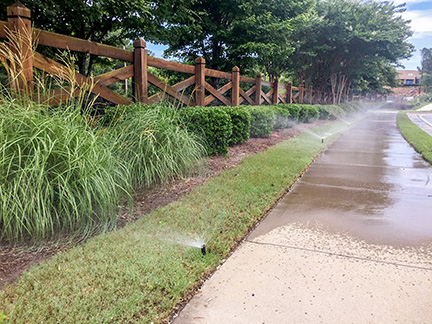A Sip or a Soak – How to Water Plants Effectively
Every summer as a child I spent one day a week hauling sprinklers around our half-acre lot every couple hours. I loathed the job, envying my neighbor’s built-in sprinkler system that ran itself for a few minutes each day. It wasn’t until I studied horticulture that I learned our system was better – at least for the lawn.
Not to say there is anything wrong with irrigation systems, quite the contrary. The difference between our method and our neighbor’s was all in the timing. Their system was programmed to give the lawn and garden a little sip of water each day, while we soaked the soil once or twice per week. Watering plants deeply and less frequently encourages deeper root growth, which helps plants cope with hot, dry weather.
How Long Should I Run Sprinklers?
Most plants require about an inch of water each week in the form of rain or supplemental irrigation. That’s a broad generalization of course, but a good jumping-off point. Cool-season grasses, for example, require more water than warm-season grasses, while some fruits require extra water during fruit production and others are sweeter when water is limited. And ornamental plants vary greatly in their water needs. Local climate also plays a big role in the water needs of plants. Get to know the plants in your landscape and their individual needs. Hint: it is best to plant varieties with similar needs together in one area of the garden to simplify watering.
Once you know how much water your plants require, determine how long to run your sprinklers or irrigation system to give them the water they need. Do this by setting out a few flat-bottomed cans or containers in the landscape and turning the sprinklers or irrigation system on for twenty minutes. Then measure how much water was collected in the containers. Multiply this by three and you know how much water your system delivers in an hour. Use this number to determine how long you need to run your irrigation system to deliver the required amount of water. This simple test works with any type of irrigation system. For drip systems, position the can beneath an emitter.
Of course, that is simplifying things a bit. You also need to pay attention to the weather and only provide additional irrigation when needed.
Slow and Steady
When irrigating, water should be applied only as quickly as it can be absorbed by the soil. It is best to deliver water slowly through a drip irrigation system, soaker hose, or pressure-regulated sprinkler head.
In lawns, look for sprinkler heads that minimize water loss due to evaporation. In general, rotary spray heads are more efficient than mist-style spray heads. Rotary heads deliver water in a thick stream, reducing mist. When using overhead hose-end sprinklers, reduce the flow rate and allow sprinklers to run long enough to penetrate the soil horizon.
For ornamental gardens try using drip irrigation, soaker hoses, micro-spray heads, and low-pressure sprinkler heads to deliver water low to the ground, minimizing water loss. These systems can be operated manually or be incorporated into an automated system.
Soil type and topography also play a role in how quickly water should be applied. In some cases, it is best to break up water delivery into two or three short cycles, allowing water to infiltrate into the soil for about 30 minutes between cycles. This is particularly true of clay soils, compacted soils, and on slopes where run off may occur. Observe the landscape when watering. If you see water begin to pool or sheet, try cycling your delivery.
Watering plants is by no means an exact science. Monitor your irrigation method and make adjustments as needed to avoid over- or under-watering. Poke around in the soil on occasion to make sure plants are receiving adequate irrigation.

